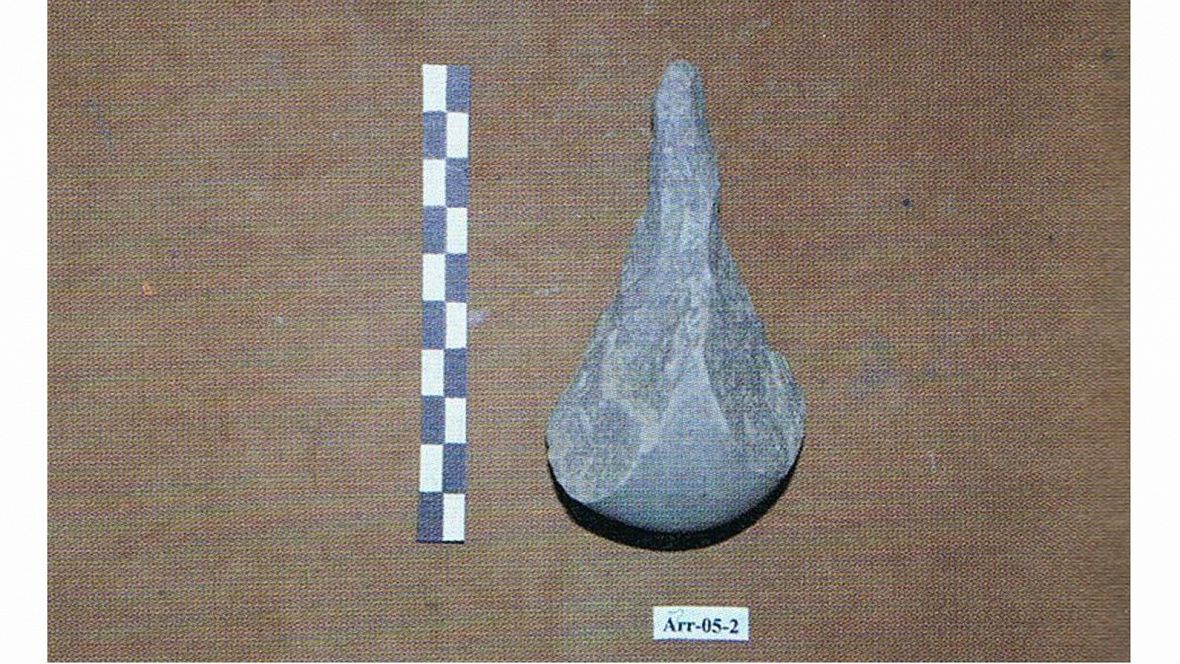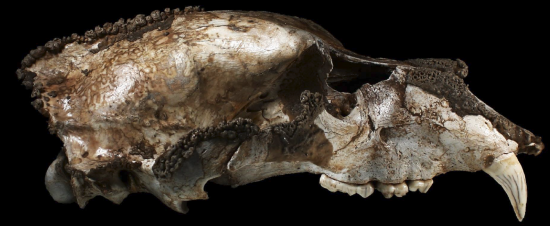Morella acogerá el Congreso Nacional de Pinturas Rupestres del 6 al 9 de febrero. Este se celebra cada año en un emplazamiento importante que alberga pinturas rupestres.Además, el congreso cuenta con la colaboración del Ministerio de Educación, Cultura y Deporte y la Consellería de Educación, Investigación, Cultura y Deporte de la Generalitat Valenciana...
Libro. La evolución humana contada a los más jóvenes
El rigor científico no está reñido con la divulgación, tampoco si el público son niños, afirma el ilustrador José María Domínguez, quien este año ha publicado “Evolución”, un libro que explica, con muchos dibujos, el proceso de la evolución de la especie humana, desde nuestros ancestros hasta el “Homo sapiens”...
Audio. Pico asturiense - MVPAC - RTVE.es
Se trata de un útil caracterisrico del Mesolitio de la Cornisa Cantabrica. Se le relaciona con actividades de marisqueo y con los concheros mesoliticos...
---
Magical new 4,500 year old finds add to 'oldest toy collection in the world'
 |
| The doll had ‘carefully worked out facial features’ and was made of soapstone. Picture: IIMK RAS |
 |
| The toy animal head is made from antler or horn. Picture: IIMK RAS |
The ‘rare’ discoveries of the pre-historic toys were made at the Itkol II burial ground in the Republic of Khakassia, southern Siberia.
The doll had ‘carefully worked out facial features’ and was made of soapstone - a soft rock made mostly of talc, said archeologist Dr Andrey Polyakov, from the Institute of History of Material Culture in St Petersburg. The head of the doll is around 5 centimetres tall.
The toy animal head is made from antler or horn.
Experts are as yet unsure what animal it depicts but it is perhaps mythical.
In both cases the bodies of the toys were made from organic material and did not preserve.
The finds were made in the grave of a ‘common child’ - not an elite burial, said Dr Polyakov...
Entrada relacionada / Related post
Ancient Axes, Spear Points May Reveal When Early Humans Left Africa
More than 1,000 stone artifacts, some of which may be up to 1.76 million years old, have been discovered at Wadi Dabsa, in southwest Saudi Arabia near the Red Sea.
The artifacts, which were found in what is now an arid landscape, date to a time when the climate was wetter; they may provide clues as to how and when different hominins left Africa, researchers said. The stone artifacts include the remains of hand axes, cleavers (a type of knife), scrapers (used to scrape the flesh off of animal hides), projectile points (that would have been attached to the ends of spears), piercers (stone tools that can cut small holes through hide or flesh) and hammer stones. One of the hand axes is unusually heavy, weighing just under 8 lbs. (3.6 kilograms), the researchers said. The discoveries were detailed in the December 2017 issue of the journal Antiquity...
Fossil from Nevada cave spurs discovery of extinct horse – Las Vegas Review-Journal
In the early days of the Great Depression, a team of researchers led by famed archaeologist Mark Harrington unearthed a treasure trove of animal fossils and ancient artifacts from a cave in the mountains east of Las Vegas. Some of the bones found inside Gypsum Cave were so well preserved, they were mistaken for modern specimens and filed away in museum collections, where they went largely overlooked until recently... (Video)
Chinese oracle bone inscriptions added to UNESCO world memory register - Xinhua
A press conference on the Chinese oracle bone inscriptions is held at the Palace Museum in Beijing, capital of China, Dec. 26, 2017. Chinese oracle bone inscriptions were included on the UNESCO Memory of the World Register, Chinese authorities announced Tuesday. Oracle bones are pieces of ox scapula or turtle plastron, which were used for divination during the late Shang Dynasty (1600-1046 B.C.)...
New riverside Neolithic settlement discovered in Trita Koromilia, Kastoria in northern Greece
In the framework of the work for the construction of the project "Vertical Axis 45 Egnatia Odos, Siatista-Kristallopigi", in the location "Trita" of the Municipality of Koromilia of the Municipality of Kastoria, in the period from October 2013 to January 2015, a large excavation a group headed by the archeologist-prehistorologist Georgatos Stratoulis, initially responsible for the former Ephorate of Prehistoric and Classical Antiquities, and since November 2014 the newly established Ephorate of Antiquities of Kastoria, revealed an area of 2,200 sq.m. of a new riparian settlement of the Modern Neolithic period...
Новосибирские археологи откопали украшение из ледникового периода - Технологии - info.sibnet.ru / Lnk 2
(Novosibirsk archaeologists have dug up the ornament from the glacial period... translate.google.es)
Más noticias / More news
---
Actualización. Hallan un gran 'almacén' de objetos y herramientas prehistóricas - RT
En el suroeste de Arabia Saudita se ha descubierto una de las mayores concentraciones de material paleolítico. Algunos de éstos instrumentos pueden tener más de 1,7 millones de años.
Un grupo de arqueólogos ha hallado más de mil artefactos en Uadi Dabsa, en el campo volcánico Harrat Al Birk, a pocos kilómetros de la costa del Mar Rojo, en el suroeste de Arabia Saudita. La gran cantidad de objetos encontrados convierte a este lugar en uno de las mayores 'depósitos' de concentración de material paleolítico.
La revista Antiquity ha publicado los resultados de este descubrimiento, que ha sido posible gracias al proyecto de los investigadores del Consejo Europeo de Investigación (ERC, por sus siglas en inglés)...
Actualización. Arqueólogos encuentran el juguete más viejo de la historia - FayerWayer
Un reportaje del diario The Siberian Times revela que un grupo de especialistas del Instituto de Historia de la Cultura Material de San Petersburgo descubrió en el distrito de Khakassia una tumba de un niño, con más de 4.500 años de antigüedad, en donde se encontraron los restos de una colección de juguetes, que serían los más viejos de la historia.
Prácticamente todos los juguetes no sobrevivieron, ya que fueron fabricados con materiales orgánicos y biodegradables, pero se destaca el hallazgo de un muñeco (mostrado en la imagen que da inicio a la nota) con cabeza y rasgos humanos faciales, hecho de esteatita, y con cerca de cinco centímetros de altura.
Esta figura intacta, sería el juguete más viejo de la historia, ya que dataría de la Era del Bronce, y según el Dr. Andrey Polyakov, arqueólogo líder de la excavación, habría pertenecido a un niño común, lejano a la élite social de aquel entonces.
Por lo que constituye una evidencia de que incluso los infantes pertenecientes a las clases sociales más bajas tenían acceso a juguetes avanzados y duraderos para su época.
El diario relata que Siberia ha sido el terreno de varios hallazgos arqueológicos con miles de años de antigüedad, así que se abre la posibilidad de que se encuentren aún más objetos.
















